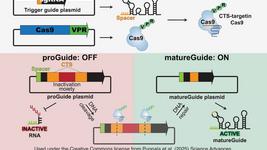CMN Weekly (24 November 2023) - Your Weekly CRISPR Medicine News
By: Gorm Palmgren - Nov. 24, 2023
Top picks
- The recent approval of the world's first CRISPR-Cas9 gene editing therapy has raised concerns about the therapy's affordability and accessibility. The new therapy, Casgevy, is developed by Vertex Pharmaceuticals for the one-time treatment of sickle cell disease and β-thalassemia. A news article in Nature Biotechnology discusses the problems of an expected price tag of around $2 million per patient and the need for an advanced healthcare infrastructure to administer autologous cell therapy. These challenges are especially relevant in low-income countries where sickle cell disease is most prevalent.
- Researchers in Sweden have identified a significant, unintended deletion in a chromosome region in CRISPR-Cas9-modified cells, not due to off-target effects but common during cell modification. This deletion, affecting vital cellular processes and observed in cancer patient genomes, underscores the necessity for rigorous evaluation of unintended genomic changes in CRISPR-Cas9 research, particularly in cancer studies.
Research
- CRISPR-Cas attack of HIV-1 proviral DNA can cause unintended deletion of surrounding cellular DNA, according to a new study by Dutch researchers. The study found that both continuous and transient CRISPR-Cas attacks on the integrated HIV DNA result in the expected small indels and frequently cause much larger deletions that can include flanking cellular DNA sequences.
- Israelian researchers have demonstrated that phages encode an arsenal of anti-defence proteins that can turn off various bacterial defence mechanisms. They analysed groups of closely related Bacillus phages that showed differential sensitivity to bacterial defence systems. They discovered four distinct families of anti-defence proteins that inhibit the Gabija, Thoeris, and Hachiman systems.
- An American study found that TnpB proteins, abundant in bacterial and archaeal genomes and related to Cas12 in CRISPR-Cas systems, show remarkable structural and biochemical adaptability. The study reveals the TnpB proteins' evolutionary versatility, evolving into various functions like CRISPR-Cas effectors and nucleases, offering prospects for future research and applications in RNA-guided systems.
- Chinese researchers have developed CRISPR-powered optothermal nanotweezers (CRONT), combining optothermal manipulation with CRISPR-based bio-detection to trap and enrich DNA functionalized nanoparticles, CRISPR proteins, and DNA strands. The CRISPR-based optical tweezers offer potential applications in diagnosis, biophotonics, and bio-nanotechnology.
- Almost 200 novel CRISPR systems have been revealed by a new search algorithm that analyses bacterial data. The new CRISPR-linked systems represent an untapped trove of diverse biochemical activities linked to RNA-guided mechanisms, with great potential for development as biotechnologies.
- American researchers have shown that CRISPR-associated transposases (CAST) can exhibit both RNA-guided and RNA-independent pathways. The study will inform further engineering of CAST systems for accurate kilobase-scale genome engineering applications.
- Researchers in Japan have optimised gene editing in antitumor T cells using CRISPR-Cas9 technology by addressing the challenge of selecting effective gRNAs for gene knockout. Combining epigenetic data from transposase-accessible chromatin sequencing with sequence-based prediction tools significantly improved gene-editing efficiency in T cells, demonstrating enhanced editing in epigenetically closed regions and unstimulated T cells with IL-7 pretreatment.
- Researchers in the US have studied a CRISPR-based homing gene drive in Culex quinquefasciatus mosquitoes, vectors for diseases like West Nile virus and lymphatic filariasis. They demonstrate that engineered homing gene drives, previously successful in Anopheles and Aedes mosquitoes, can be extended to Culex species, indicating potential for developing new mosquito control strategies.
- Chinese researchers have introduced CRISOT, an integrated tool suite utilizing molecular dynamics simulations for CRISPR systems, aimed at improving genome-wide off-target prediction and sgRNA optimization. CRISOT, with its modules for RNA-DNA interaction fingerprint generation and specificity evaluation, outperforms existing tools and shows promise in accurately predicting off-target effects, offering a more efficient and generalizable framework for CRISPR genome editing.
- Researchers from Iran have used CRISPR to generate a zebrafish model of human retinitis pigmentosa (RP) diseases. The model employs rpe65a knock-out zebrafish and can be used in RP pathophysiology studies and preclinical gene therapy experiments.
- Chinese researchers have engineered extracellular vesicles (EVs) to deliver functional Cas9/gRNA to eliminate hepatitis B virus cccDNA and integration. The engineered EVs successfully delivered CRISPR-Cas9 both in vitro and in vivo, leading to the clearance of episomal cccDNA and integrated viral DNA fragments.
Industry
- Want to know the current standings in the CRISPR patent battle? German IP lawyer and neurobiologist Ulrich Storz gives an overview of the status quo ten years after the seminal patents were filed. He concludes that the licensing situation in CRISPR-Cas9 remains complicated, though the last years have at least unmasked strengths and weaknesses of the seminal patent portfolios owned by the major players. Moreover, it has exposed fundamental differences between the European and American patent systems.
Detection
- American researchers have introduced an asymmetric CRISPR assay that leverages competitive crRNA and Cas12a to enable cascade signal amplification for nucleic acid detection, eliminating the need for pre-amplification and allowing quantitative analysis. This method, which can detect RNA/DNA fragments directly, was successfully used to quantify microRNA in plasma samples from bladder cancer patients, showing its potential for various diagnostic applications.
- Researchers in the US have developed a new class of protease activity sensors called DNA-barcoded plasmonic nanostructures that use gold nanoparticles functionalised with peptide-DNA conjugates for highly sensitive and selective detection of proteases. Detection of SARS-CoV-2-associated protease demonstrated significant advantages in sensitivity, response rate, and multiplexing capabilities, showing great potential for biosensing and disease diagnostics, including in challenging biological samples.
Reviews
- Next-generation forward genetic screens: uniting high-throughput perturbations with single-cell analysis. This review looks at technologies that pair CRISPR screens with single-cell multi-omics and the unique opportunities afforded by extending pooled screens using deep multimodal phenotyping.
- CRISPR/Cas-powered amplification-free detection of nucleic acids: Current state of the art, challenges, and futuristic perspectives. This review covers the current methods, pros and cons of pre-amplification in CRISPR-based diagnostics (CRISPR-Dx) and emerging strategies for amplification-free detection while addressing future challenges and perspectives in this field.
- CRISPR/Cas9: a powerful tool in colorectal cancer research. This review elucidates the mechanism of the CRISPR-Cas9 system and its comprehensive applications in colorectal cancer (CRC). Additionally, it discusses the issue of off-target effects associated with CRISPR-Cas9, which serves to restrict its practical application.
News from CRISPR Medicine News
- This Monday, we brought an interview with AAV trailblazer Nicole Paulk, formerly of UCSF, who speaks about the latest developments in AAV-based gene therapies and her new company, Siren Biotechnology.
- On Wednesday, we looked at recent clinical updates from the gene-editing field. These updates include clinical data from ongoing clinical trials for acute myeloid leukaemia and transthyretin amyloidosis and IND clearance for Caribou Biosciences' acute myeloid leukaemia candidate, CB-012.
Huh, heh, wow
- A news article in Nature describes how scientists in Germany and Japan have independently used CRISPR gene editing in cuttlefish embryos to study their complex skin patterns and brain activity despite challenges in adapting the technology for these organisms. The original papers were published back-to-back this summer in Nature (here and here) and include high-resolution imaging of skin cells and e-ink technology for environmental simulation. They aim to unravel the mechanisms behind cuttlefish's rapid, colour-blind camouflage and explore broader biological phenomena like sleep evolution and interspecies communication.
To get more of the CRISPR Medicine News delivered to your inbox, sign up to the free weekly CMN Newsletter here.
Tags
CLINICAL TRIALS
IND Enabling
Phase I
Phase II
Phase III
Gastric Cancer and Colorectal Cancer, CRC, (NCT07166263)
Sponsors:
Base Therapeutics (Shanghai) Co., Ltd.
Sponsors:
Base Therapeutics (Shanghai) Co., Ltd.
IND Enabling
Phase I
Phase II
Phase III
Relapsed or Refractory Acute Myeloid Leukemia, AML, (NCT06541444)
Sponsors:
Base Therapeutics (Shanghai) Co., Ltd.
Sponsors:
Base Therapeutics (Shanghai) Co., Ltd.
IND Enabling
Phase I
Phase II
Phase III







